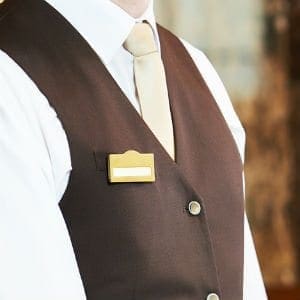 A short detour through Southern California brought me to an independent property advertising itself as a ‘lifestyle hotel’. Not knowing the specifics of what this meant in a West Coast context, who exactly this hotel was targeting or how the property was differentiating itself to substantiate this modifier, I was curiously excited to try it out.
A short detour through Southern California brought me to an independent property advertising itself as a ‘lifestyle hotel’. Not knowing the specifics of what this meant in a West Coast context, who exactly this hotel was targeting or how the property was differentiating itself to substantiate this modifier, I was curiously excited to try it out.
Withholding its name so we can keep this discussion neutral, the property itself was a one-time Hyatt that had seen a recent – and what I am told was, extensive – renovation. The open concept lobby’s enormous size was augmented by its sleek, reflective tile surfaces and made only more inviting by the vibrant reddish orange hues utilized in the sparse décor. The patchwork lighting was eclectic and moody, as was the labyrinthine juxtaposition of the lobby furniture and bar area. Furthermore, a large grab-and-go outlet reminiscent of a humble, luxury-goods-oriented airport duty free shop dominated one side of the lobby just before the entrance to the restaurant. The overall feel was relaxed and inviting, yet also animated and hip.
The front desk staff was no different than what one would expect in a traditional hotel, with the exception of a lack of name badges. The property was very busy, and I was advised by the desk clerk that they were expecting to sell out that evening. Looking around my double queen guestroom, I noticed the traditional binder of statistics, safety data, TV channels, conference space maps and room service listings had been replaced by a bound, well curated series of cardboard flip charts, each one depicting an element of the property’s features. All was presented in a laid back, millennial-seeking lexicon.
Apart from this element, the bedroom and bathroom were traditional in every other way. Towels, amenities, bed linens, soft goods and case goods looked catalog-familiar. The neutral brown color selections and bland interior design elements lacked clear-cut distinctiveness. Writing this just one week later, I am having a hard time remembering the specific combination of textures and shades which served create any sort of ‘lifestyle roar’.
So, what is it that differentiates or allows your property to be described as a lifestyle brand? One would expect – or at least a traveling boomer such as myself would surmise – that a strong sense of place would be a key factor contributing to this descriptor. After all, lifestyle’s dictionary meaning pertains to the ways in which a person or group lives. And aren’t our surroundings an important influence on our behavior or livelihoods? Moreover, shouldn’t lifestyle hotels work to enrich or improve our lives in ways that other standardized hotels simply cannot do? A lobby bar and c-store are really not enough.
From this example, I would say that lifestyle means a younger, less formal attitude, which translates into youthful front desk staff, lax uniform code, irreverent guest communications, creative use of print elements and a lively website. Perhaps the word ‘lifestyle’ just isn’t meant for those of us over the age of 45.
Not to seem jaded, but from this experience (amongst others) it would seem as though the promise of a lifestyle property has been hijacked by savvy marketers hoping to fully reposition a hotel without changing all that much to the appearance or the operations. My token of advice for you is, if you are currently operating a lifestyle hotel or are thinking of moving in that direction, give some serious thought as to how exactly you will transform your property to make it truly distinctive, but also better than your competitors.
About the author
 Larry Mogelonsky (larry@lma.net) is the president and founder of LMA Communications Inc. (www.lma.ca), an award-winning, full service communications agency focused on the hospitality industry (est. 1991). Larry is also the developer of Inn at a Glance hospitality software. As a recognized expert in marketing services, his experience encompasses Four Seasons Hotels & Resorts and Preferred Hotels & Resorts, as well as numerous independent properties throughout North America, Europe and Asia. Larry is a registered professional engineer, and received his MBA from McMaster University. He’s also a principal of Cayuga Hospitality Consultants, an associate of G7 Hospitality and a member Laguna Strategic Advisors. His work includes three books “Are You an Ostrich or a Llama?” (2012) and “Llamas Rule” (2013) and “Hotel Llama” (2014). You can reach Larry at larry@lma.ca to discuss any hospitality business challenges or to review speaking engagements.
Larry Mogelonsky (larry@lma.net) is the president and founder of LMA Communications Inc. (www.lma.ca), an award-winning, full service communications agency focused on the hospitality industry (est. 1991). Larry is also the developer of Inn at a Glance hospitality software. As a recognized expert in marketing services, his experience encompasses Four Seasons Hotels & Resorts and Preferred Hotels & Resorts, as well as numerous independent properties throughout North America, Europe and Asia. Larry is a registered professional engineer, and received his MBA from McMaster University. He’s also a principal of Cayuga Hospitality Consultants, an associate of G7 Hospitality and a member Laguna Strategic Advisors. His work includes three books “Are You an Ostrich or a Llama?” (2012) and “Llamas Rule” (2013) and “Hotel Llama” (2014). You can reach Larry at larry@lma.ca to discuss any hospitality business challenges or to review speaking engagements.
This article may not be reproduced without the expressed permission of the author.















